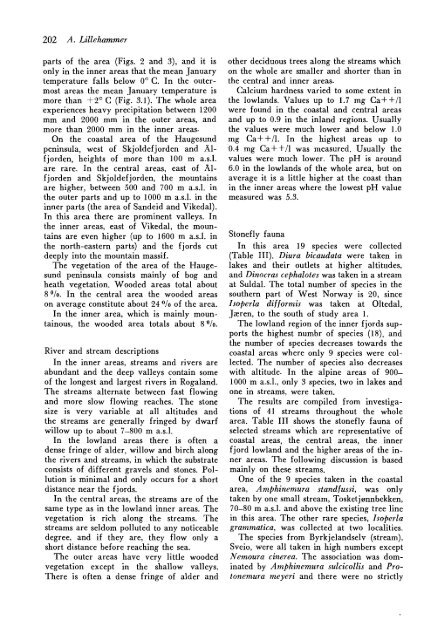Full-text - Norsk entomologisk forening
Full-text - Norsk entomologisk forening
Full-text - Norsk entomologisk forening
You also want an ePaper? Increase the reach of your titles
YUMPU automatically turns print PDFs into web optimized ePapers that Google loves.
202 A. Lillehammer<br />
parts of the area (Figs. 2 and 3), and it is<br />
only in the inner areas that the mean January<br />
temperature falls below 0° C. In the outermost<br />
areas the mean January temperature is<br />
more than +2° C (Fig. 3.1). The whole area<br />
experiences heavy precipitation between 1200<br />
mm and 2000 mm in the outer areas, and<br />
more than 2000 mm in the inner areas·<br />
On the coastal area of the Haugesund<br />
peninsula, west of Skjoldefjorden and Alfjorden,<br />
heights of more than 100 m a.s.l.<br />
are rare. In the central areas, east of Alfjorden<br />
and Skjoldefjorden, the mountains<br />
are higher, between 500 and 700 m a.s.!. in<br />
the outer parts and up to 1000 m a.s.l. in the<br />
inner parts (the area of Sandeid and Vikedal).<br />
In this area there are prominent valleys. In<br />
the inner areas, east of Vikedal, the mountains<br />
are even higher (up to 1600 m a.s.!. in<br />
the north-eastern parts) and the fjords cut<br />
deeply into the mountain massif.<br />
The vegetation of the area of the Haugesund<br />
peninsula consists mainly of bog and<br />
heath vegetation. Wooded areas total about<br />
8 0 /0. In the central area the wooded areas<br />
on average constitute about 24 % of the area.<br />
In the inner area, which is mainly mountainous,<br />
the wooded area totals about 8 %.<br />
River and stream descriptions<br />
In the inner areas, streams and rivers are<br />
abundant and the deep valleys contain some<br />
of the longest and largest rivers in Rogaland.<br />
The streams alternate between fast flowing<br />
and more slow flowing reaches. The stone<br />
size is very variable at all altitudes and<br />
the streams are generally fringed by dwarf<br />
willow up to about 7-800 m a.s.l.<br />
In the lowland areas there is often a<br />
dense fringe of alder, willow and birch along<br />
the rivers and streams, in which the substrate<br />
consists of different gravels and stones. Pollution<br />
is minimal and only occurs for a short<br />
distance near the fjords.<br />
In the central areas, the streams are of the<br />
same type as in the lowland inner areas. The<br />
vegetation is rich along the streams. The<br />
streams are seldom polluted to any noticeable<br />
degree, and if they are, they flow only a<br />
short distance before reaching the sea.<br />
The outer areas have very little wooded<br />
vegetation except in the shallow valleys.<br />
There is often a dense fringe of alder and<br />
other deciduous trees along the streams which<br />
on the whole are smaller and shorter than in<br />
the central and inner areas.<br />
Calcium hardness varied to some extent in<br />
the lowlands. Values up to 1. 7 mg Ca++/1<br />
were found in the coastal and central areas<br />
and up to 0.9 in the inland regions. Usually<br />
the values were much lower and below 1.0<br />
mg Ca++/1. In the highest areas up to<br />
0.4 mg Ca + +/1 was measured. Usually the<br />
values were much lower. The pH is around<br />
6.0 in the lowlands of the whole area, but on<br />
average it is a little higher at the coast than<br />
in the inner areas where the lowest pH value<br />
measured was 5.3.<br />
Stonefly fauna<br />
In this area 19 species were collected<br />
(Table Ill). Diura bicaudata were taken in<br />
lakes and their outlets at higher altitudes,<br />
and Dinocras cephalotes was taken in a stream<br />
at Suldal. The total number of species in the<br />
southern part of West Norway is 20, since<br />
lsoperla difformis was taken at Oltedal,<br />
]

















